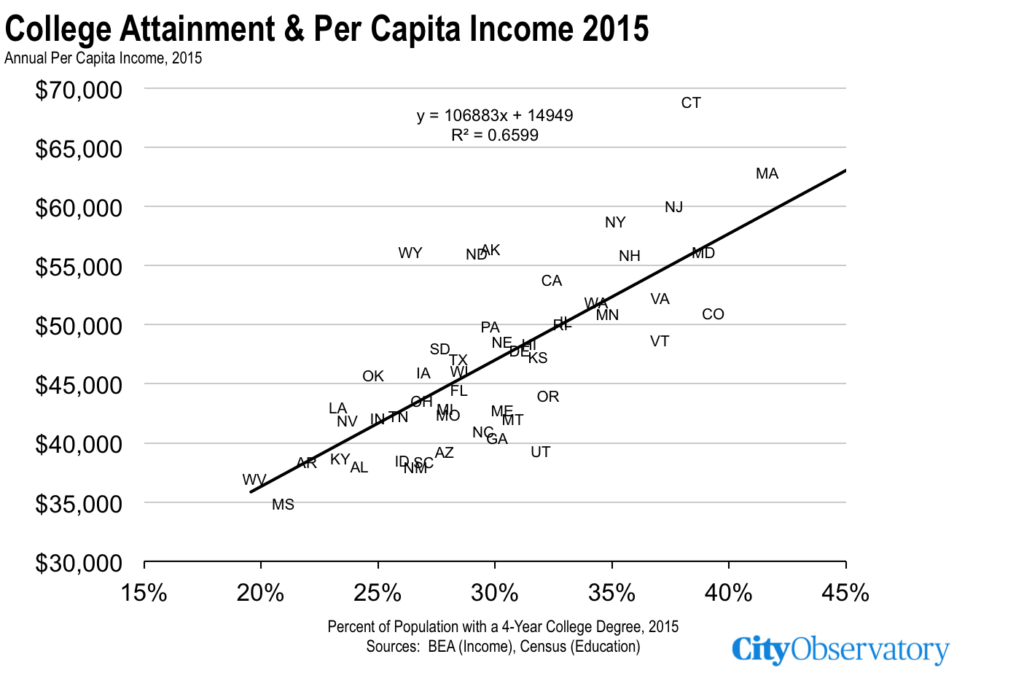One of the themes we stress at City Observatory is the large and growing importance of talent (the education and skills of the population) to determining regional and local economic success. As we shift more and more to a knowledge-based economy, the places that will do well, and that are resilient in the face of change are the one’s with the best-educated populations.
One of the most robust statistical relationships we’ve observed is the strong correlation between the four-year college attainment rate (measuring the fraction of the adult population that’s completed at least a four-year college degree) and a place’s per capita income (its total income divided by the total population). Places with better educated populations have higher incomes. While we generally focus on the relationship at the metro level, we thought we’d step back this week and look at state level data over the past quarter century to see how this relationship has evolved.
Let’s start in 1990, and look at the correlation between state per capita income and the percent of the state’s adults with at least a four-year degree. To facilitate comparisons with more recent data, we’ve expressed 1990 per capita incomes in 2015 dollars using the Implicit Price Deflator for Personal Consumption Expenditures. This table shows how a state’s educational attainment in 1990 was correlated with its average income in 1990.

The data show a strong positive correlation. Each one percentage point increase in the adult population with a four year degree was associated with an increase of about $950 dollars (expressed in 2015 dollars). In a statistical sense, variations in education explain about 6x percent of the variation in per capita income among states.
Now move forward to 2015, the latest year for which we have state level data on educational attainment and per capita income. This chart has the same setup, but now shows 2015 adult educational attainment compared to 2015 levels of per capita income. Its similar, but now the relationship is stepper (each one percentage point increase in educational attainment in a state is now equal to a $1,070 increase in per capita income, and education alone explains 66 percent of the variation in income between states. Keep in mind that idiosyncratic factors beyond educational attainment matter to state income: still flush from the oil boom, Wyoming, North Dakota and Alaska all had much higher per capita income in 2015 than one would expect based on education alone.

Together these two charts show that education is a strong and increasingly important factor related to state income growth. But what’s interesting is to go a step further and put these two analyses together. What we’ve done in the following chart is to compare 1990 levels of educational attainment (i.e. what fraction of a state’s adults had a four-year degree 25 years ago, and compare it to today’s level of per capita income. That relationship is shown here.

The key finding here is that 1990 educational attainment was a better predictors (i.e. higher coefficient of determination ) of 2015 income that it was of 1990 income. That is, educational attainment in 1990 was more strongly correlated with income 25 years later than in the current year. Each one percentage point increase in the four-year attainment rate in 1990 was associated with $1,600 higher per capita income in 2015. The most obvious reason for this is that many of the 1990 college educated citizens in a state were still around 25 years later. More generally, though, states with high levels of education (and income) may be more likely to invest in education, and send their children to college, and also be places that attract even more college graduates. Either way, the persistence of educational attainment seems to be a key factor correlated with long-term economic well-being.
The reason to pursue a talent-centered economic development strategy should be a strong motivation to reap the long-term benefits of a well-educated population.
A hat-tip to our colleague Phineas Baxendall at the Massachusetts Budget & Policy Center points us to similar work done by his organization which looks at the median wage for all workers by state, and compares it to each state’s college attainment rate. As with our analysis, there’s a very strong correlation.
